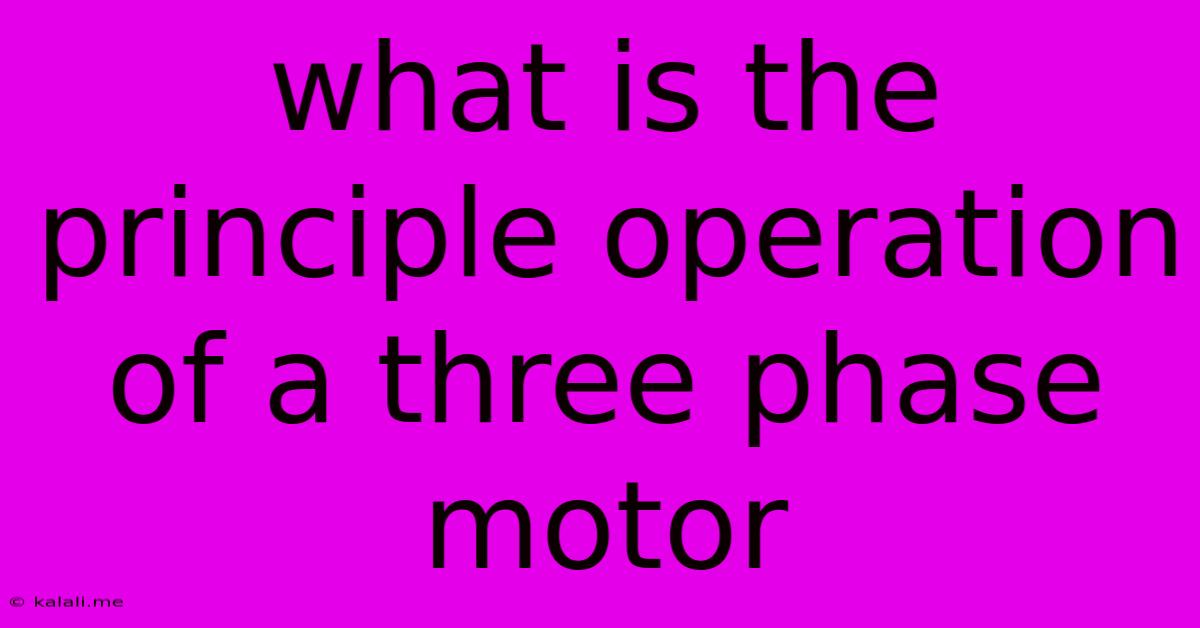What Is The Principle Operation Of A Three Phase Motor
Kalali
Jun 14, 2025 · 3 min read

Table of Contents
Understanding the Principle Operation of a Three-Phase Motor
This article will delve into the fundamental principles governing the operation of a three-phase induction motor, a ubiquitous workhorse in industrial and commercial applications. We'll explore how a simple rotating magnetic field is created and how that field interacts with the motor's rotor to produce mechanical torque. Understanding these core principles is key to appreciating the efficiency and reliability of this vital electrical machine.
Three-phase motors are preferred over single-phase motors due to their higher efficiency, power-to-size ratio, and inherent self-starting capabilities. Their operation relies on the interaction between a rotating magnetic field generated in the stator and the induced currents in the rotor. Let's break down the process step-by-step.
The Rotating Magnetic Field: The Heart of the Operation
The stator, the stationary part of the motor, houses three sets of windings, each physically displaced by 120 electrical degrees. These windings are connected to a three-phase power supply – a source providing three sinusoidal voltages, each 120 degrees out of phase with the others. This phase difference is crucial.
When the three-phase power is applied, each winding carries a current that varies sinusoidally. Because of the 120-degree spatial displacement and the phase difference in the currents, a rotating magnetic field is produced. Imagine three magnets, each rotating at the same speed but offset in their position. The combined effect creates a single, rotating magnetic field. The speed of this rotating magnetic field is directly proportional to the frequency of the supply voltage. This is called the synchronous speed.
Rotor Response and Torque Production: Interaction and Motion
The rotor, typically a squirrel cage or wound rotor, is placed within this rotating magnetic field. The rotating field induces currents in the rotor conductors (either through electromagnetic induction or by direct connection in a wound rotor). These induced currents, in turn, create their own magnetic field. The interaction between the rotating magnetic field of the stator and the induced magnetic field of the rotor produces a force that causes the rotor to rotate.
This principle is based on the fundamental law of physics: opposite poles attract and like poles repel. The rotor tries to align its magnetic field with the rotating magnetic field of the stator, continuously chasing the rotating field. This continuous chase results in the rotor's rotation, generating mechanical torque.
Slip: The Difference Between Synchronous and Rotor Speeds
The rotor never quite reaches the synchronous speed of the rotating magnetic field. This difference in speed is known as slip. Slip is essential for the induction of currents in the rotor and, therefore, for torque production. If the rotor were to spin at the synchronous speed, there would be no relative motion between the rotor and the stator's rotating magnetic field, and no induced current would exist to produce torque. The slip is usually expressed as a percentage of the synchronous speed.
Types of Three-Phase Motors: Squirrel Cage vs. Wound Rotor
There are two main types of three-phase induction motors:
-
Squirrel Cage Motors: These are the most common type. The rotor consists of conductive bars embedded in a steel core, forming a cage-like structure. They are simple, rugged, and relatively inexpensive.
-
Wound Rotor Motors: These motors have a wound rotor with slip rings and brushes. External resistors can be connected to the rotor windings to control the motor's speed and starting torque. They offer greater controllability but are more complex and expensive.
Conclusion: A Powerful and Efficient Design
The operation of a three-phase motor is a testament to the elegant simplicity and effectiveness of electromagnetic principles. The generation of a rotating magnetic field in the stator and its interaction with the rotor's induced currents provides a powerful, reliable, and efficient way to convert electrical energy into mechanical work, making it a cornerstone technology across numerous industries. Understanding these fundamental principles provides a solid foundation for anyone working with or studying electrical machinery.
Latest Posts
Latest Posts
-
Which Of The Following Is Similar Between Rna And Dna
Jun 15, 2025
-
What Act Score Do You Need To Get Into Lsu
Jun 15, 2025
-
Washington University In St Louis Gpa Requirements
Jun 15, 2025
-
Electron Volt Is The Unit Of
Jun 15, 2025
-
Average Sat Score For Umass Amherst
Jun 15, 2025
Related Post
Thank you for visiting our website which covers about What Is The Principle Operation Of A Three Phase Motor . We hope the information provided has been useful to you. Feel free to contact us if you have any questions or need further assistance. See you next time and don't miss to bookmark.